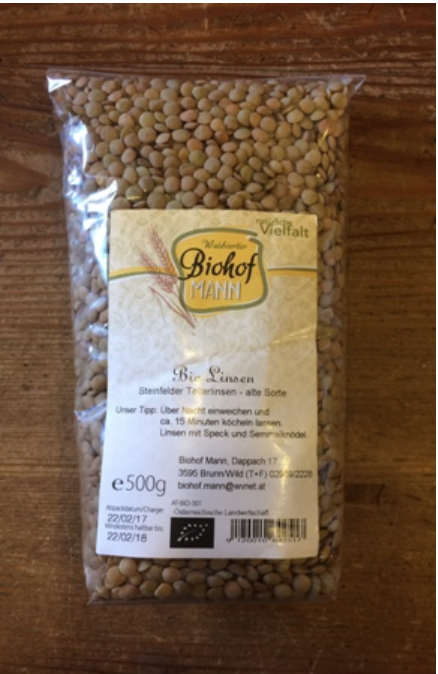Crop: Lens culinaris Medik. (Lentil )
The ‘Steinfelder Tellerlinse’ has brown-green lentils with good flavour. What makes this cultivar special is its high suitability for low-input conditions and dry, stony soils. In Austria, this lentil is traditionally served with dumplings.
Cultivation System: organic/ low-input conditions.
Geographical Information
Country: Austria
The cultivation of the landrace was always concentrated in the Southern part of the ‘Wiener Becken’ (Viennese Valley), 60 km South of Vienna. Nowadays, it is also cultivated in the North-West part of Lower Austria where soil conditions are similar.
Farmer(s) description:
There are around 5 farms which grow this old regional lentil landrace, which, in most cases, are organic farms that specialize in old cereal cultivars and sometimes combine cereal and lentil field crops.
Propagation system: Seed, self-pollination
Multiplication procedures and consequences on landrace diversity:In lentil, outcrossing may occur at a maximum of 5%. Multiplication is carried out at the ‘original’ farm which has been cultivating ‘Steinfelder Tellerlinse’ for centuries, as well as at another farm on behalf of ARCHE NOAH.
Management plan existence:The landrace management relies mainly on farming activities within the area. Currently, no technical or scientific support is given. ARCHE NOAH has the cultivar in its collection, and is responsible for multiplication every few years.
Added Values
‘Steinfelder Tellerlinse’ is available through the online store of the aforementioned conservation farm as well as directly on farms who are cultivating this cultivar. It is also sold directly to a restaurant in the original region. Large supermarket chains in Austria still see locally-grown lentils as a niche and therefore focus on supplying foreign lentil varieties.
Others (e.g. commercial/geographical brands or special traits):The ‘Slow Food’ movement had paid special attention to the ‘Steinfelder Tellerlinse’ several years ago (around 2010), but there haven’t been continued efforts since.
There is no external support for this landrace.
The conservation will probably depend on few farmers and on ARCHE NOAH.
Seeds can be accessed through ARCHE NOAH and some farms:
Case study provided by Arche Noah, Austria.
ND.
